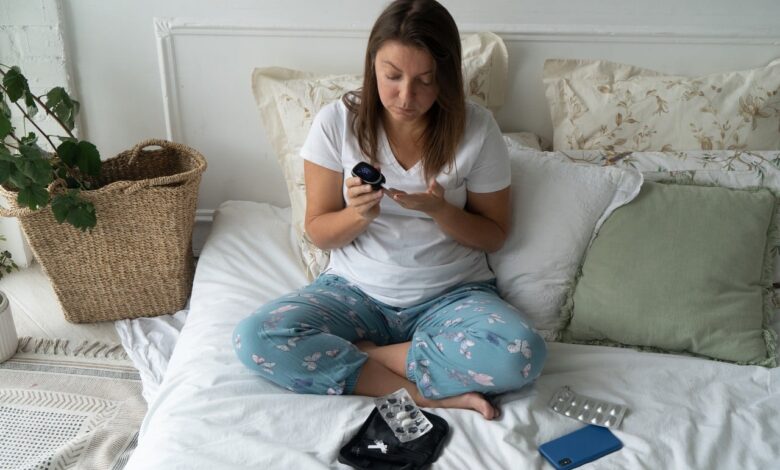Somogyi Effect: Navigating Blood Sugar Swings In Diabetes: HealthifyMe

Navigating the complexities of managing diabetes introduces us to various phenomena that directly impact blood glucose levels. Among these, the Somogyi effect is a critical concept for those striving to maintain balanced glucose levels. This phenomenon, named after the scientist Michael Somogyi who first described it, is a counter-regulatory response to hypoglycemia (low blood sugar levels), which leads to hyperglycemia (high blood sugar levels) upon waking.
Understanding the Somogyi effect is crucial for anyone looking to fine-tune their diabetes management strategies, as it highlights the body’s intricate balance between insulin use and glucose production.
The Somogyi effect primarily occurs in individuals with diabetes who use insulin. It manifests as an unexpectedly high blood sugar level in the morning, a baffling scenario for many who diligently monitor their glucose. The body, in its attempt to counteract hypoglycemia experienced during sleep, releases stress hormones, which in turn increase blood sugar levels. This effect is often mistaken for the dawn phenomenon, another glucose-related occurrence with similar morning hyperglycemia outcomes but different causes. Distinguishing between these two can significantly influence one’s approach to diabetes management.
This article aims to explain everything about the Somogyi effect, its causes, symptoms, and ways to prevent and treat it.
What is the Somogyi Effect?
The Somogyi effect might sound complex, but it is an essential concept for anyone dealing with diabetes, especially those on insulin therapy. In simple terms, it is a cycle where blood sugar levels swing from very low to very high. It usually happens overnight and is a reaction to the body’s attempts to deal with low blood sugar levels, also known as hypoglycemia.
When blood sugar drops too low, the body kicks into emergency mode. It releases hormones like cortisol, adrenaline, glucagon, and growth hormones to boost blood sugar levels. Glucagon plays a key role here by telling the liver to convert stored glycogen into glucose, raising blood sugar levels. However, these stress hormones also make the body’s cells less responsive to insulin (a state known as insulin resistance), leading to higher blood sugar levels by morning.
According to the theory of the Somogyi effect, when insulin lowers blood sugar, it can trigger a paradoxical impact due to the presence of hormones. They put blood sugar levels into a rebound high. It is more prevalent in the case of type 1 diabetes than type 2 diabetes. The Somogyi effect is a theory. It is not proven to be a fact. However, there is scientific evidence that supports it. On the other hand, some contradictory views and studies negate the Somogyi effect.
Summary
The Somogyi effect is a pivotal concept for those managing diabetes, particularly for insulin users, characterised by a nocturnal dip in blood sugar followed by a morning surge. This cycle is the body’s overcorrection for hypoglycemia, driven by the release of hormones that not only raise glucose levels but also induce insulin resistance, complicating diabetes management. While some evidence supports its existence, it remains a subject of debate within the medical community.
The Difference Between the Somogyi Effect and the Dawn Phenomenon
In managing diabetes, understanding the subtle differences between the Somogyi effect and the dawn phenomenon is crucial for effective blood sugar control. Both phenomena result in elevated blood sugar levels in the morning but stem from distinct causes. Recognising these differences enables individuals with diabetes to tailor their management strategies more accurately.
Cause of High Morning Blood Sugar
Somogyi Effect: This effect is a reactive process. It occurs as the body’s response to hypoglycemia (low blood sugar) during the night. To combat low blood sugar, the body releases hormones that increase blood sugar, often overshooting into hyperglycemia by morning.
Dawn Phenomenon: This phenomenon is due to the body’s natural circadian rhythm. During the early morning hours, the body releases growth hormones, cortisol, and other substances that increase insulin resistance, leading to higher blood sugar levels upon waking.
Diagnostic Clues
Somogyi Effect: Identifying this effect involves checking blood sugar levels in the middle of the night (around 2-3 AM). If the blood sugar is low at this time, it suggests that the high morning blood sugar is a rebound effect from hypoglycemia. To monitor your blood sugar levels so late at night, consider using a Continuous Glucose Monitor. The HealthifyMe CGM monitors your blood sugar levels at all times and can help you monitor your blood sugar levels perfectly.
Dawn Phenomenon: If blood sugar levels are normal or high during the early morning hours and increase further by morning, it points towards the dawn phenomenon. This pattern indicates a natural rise in blood sugar without preceding hypoglycemia.
Prevalence
While both conditions can cause morning hyperglycemia, the dawn phenomenon is more commonly observed among individuals with diabetes. It is a universal response to hormonal changes that affect blood sugar regulation.
Management Strategies
Addressing the Somogyi effect may require adjusting the evening insulin dose to prevent nighttime hypoglycemia. For the dawn phenomenon, altering the timing or type of insulin may help counteract the morning rise in blood sugar.
Summary
While both the Somogyi effect and the dawn phenomenon lead to elevated morning blood sugar levels, their triggers differ significantly. The Somogyi effect is a response to nocturnal hypoglycemia, while the dawn phenomenon arises from hormonal changes during sleep. Understanding these differences is vital to adjusting diabetes management strategies effectively.
Symptoms of the Somogyi Effect
Understanding the symptoms of the Somogyi effect is vital for individuals with diabetes, particularly for those managing their condition with insulin. This phenomenon, which can disrupt a well-structured diabetes management plan, manifests through several signs that are often overlooked or attributed to other causes. Identifying these symptoms can be the key to adjusting treatment strategies and preventing the unwanted morning hyperglycemia that characterises the Somogyi effect.
- Morning Hyperglycemia: The hallmark sign of the Somogyi effect is high blood sugar levels upon waking. You can monitor this effectively with a Continuous Glucose Monitor (CGM), which tracks glucose levels throughout the night and provides insights into nocturnal glucose trends.
- Nocturnal Hypoglycemia: Although one cannot directly observe this, signs such as sweating, nightmares, or waking up feeling jittery can indicate low blood sugar levels at night. It triggers a rebound hyperglycemia by morning.
- Daytime Fatigue: Despite adequate rest, individuals experiencing the Somogyi effect may report unexplained tiredness or fatigue during the day. It is a consequence of disrupted sleep patterns due to nocturnal hypoglycemic episodes.
- Changes in Appetite: An increase in hunger or altered appetite can also signal fluctuating blood sugar levels. That is because the body attempts to regulate its energy supply in response to perceived glucose imbalances.
- Mood Variations: Irritability, mood swings, and difficulty concentrating can arise from the stress placed on the body by repeated hypoglycemic and hyperglycemic events. It impacts overall emotional well-being.
Summary
The Somogyi effect, characterised by nocturnal hypoglycemia followed by morning hyperglycemia, presents through a spectrum of symptoms that extend beyond simple glucose measurements. Recognising these signs (ranging from overnight sweating and daytime fatigue to mood changes and altered appetite) can prompt individuals with diabetes and their healthcare providers to investigate further and adjust treatment protocols.
Causes of the Somogyi Effect
Understanding what triggers the Somogyi effect is crucial to managing diabetes. This phenomenon, where blood sugar levels rise in response to a nighttime drop, can perplex even the most diligent individuals managing their condition. Here’s a breakdown of the primary factors that can lead to the Somogyi effect.
1. Excessive Insulin Dosage
One of the most straightforward causes is administering too much insulin before bed. Insulin’s role is to lower blood sugar. However, excess usage can dip too low during sleep, prompting the body to react by increasing sugar levels too much by morning.
2. Skipped or Light Meals
Not eating enough in the evening can leave your body with insufficient glucose to sustain overnight energy needs. This scarcity prompts a defensive reaction, causing the liver to release stored glucose. This process can overshoot blood sugar into high morning levels.
3. Incorrect Insulin Timing
Insulin timing is as crucial as dosage. Insulin that peaks in its action during the night can lower glucose levels excessively, especially if it does not align with the body’s natural nighttime glucose use.
4. Alcohol Consumption
Drinking alcohol can affect the liver’s ability to release glucose overnight. Alcohol tends to inhibit glucose production, leading to lower levels that trigger a rebound high by morning.
5. Stress and Illness
Both stress and illness can increase hormone levels that counteract insulin, such as cortisol and adrenaline. These hormones can cause blood sugar levels to fluctuate significantly, contributing to the Somogyi effect.
6. Irregular Meal Patterns
Inconsistent eating schedules can disrupt your body’s glucose management. Skipping meals or eating at varying times can lead to imbalances in insulin effectiveness and the body’s glucose levels.
7. Medication Interactions
Other medications, whether for diabetes or different conditions, can interact with insulin in unpredictable ways, influencing how the body manages glucose overnight.
Summary
The Somogyi effect can arise from various factors, primarily related to insulin management, dietary habits, and the body’s natural responses to low glucose levels. By understanding these triggers (ranging from excessive insulin dosage to stress, illness, and even alcohol consumption), individuals can better navigate the challenges of maintaining stable blood sugar levels. Recognising and adjusting these factors can significantly mitigate the risk of experiencing the Somogyi effect.
Steps to Diagnose the Somogyi Effect
Identifying the Somogyi effect involves more than just recognising symptoms; it requires a detailed investigation into your blood sugar patterns, especially during the night. Understanding how to pinpoint this phenomenon is essential for anyone managing diabetes, as it can significantly impact your treatment plan and daily well-being.
- Blood Sugar Monitoring at Night: Begin by checking your blood sugar levels before you go to bed. This initial reading provides a baseline to compare against later measurements.
- Midnight Checks: Set an alarm for a 3:00 a.m. blood sugar check. This step is crucial because it helps capture your glucose level at a critical point. If your sugar is low at this time, it might indicate that a nocturnal drop is triggering a rebound increase by morning.
- Morning Readings: Upon waking, immediately recheck your blood sugar levels. A significant rise from the 3:00 a.m. reading could suggest the Somogyi effect.
- Continuous Glucose Monitoring (CGM): For a more comprehensive view, consider using a CGM device. It can track your glucose levels throughout the night, providing detailed insights into your patterns without disrupting your sleep.
- Log Your Findings: Keep a detailed record of your readings, along with notes on your insulin doses, evening meals, and any nighttime awakenings or symptoms. This log can help your healthcare provider see the bigger picture and make a more accurate diagnosis.
Share your findings with your doctor or diabetes care team. They can analyse the patterns and, if necessary, perform further tests to confirm the Somogyi effect.
Summary
Diagnosing the Somogyi effect is a meticulous process that involves tracking blood sugar levels at specific times during the night and upon waking. By understanding your body’s glucose patterns and working closely with healthcare professionals, you can identify and manage this condition effectively.
Managing the Somogyi Effect: A Comprehensive Approach
Addressing the Somogyi effect, a balance of insulin management and lifestyle adjustments is paramount for individuals with diabetes. This condition, marked by a cycle of nocturnal hypoglycemia followed by morning hyperglycemia, requires a nuanced understanding and a proactive stance for effective management. Here’s how to approach prevention, treatment, and long-term management of the Somogyi effect, ensuring a more stable and predictable blood sugar profile.
Preventive Measures
Adjust Insulin Dosage and Timing: Work closely with your healthcare provider to find the optimal insulin regimen that minimises the risk of nocturnal hypoglycemia. It may involve adjusting the dose or timing of insulin or switching to a different type of insulin.
Evening Snacks: Incorporating a balanced snack before bedtime can help prevent overnight blood sugar dips. Choose snacks with a mix of complex carbohydrates, protein, and healthy fats to provide a steady release of glucose.
Lifestyle Modifications: Regular exercise, stress reduction techniques, and prioritising sleep can significantly impact blood sugar stability. Establish a routine that supports your body’s natural rhythms and insulin sensitivity.
Treatment Strategies
Continuous Glucose Monitoring (CGM): Devices like the HealthifyMe CGM offer real-time insights into glucose levels, enabling more precise adjustments to diabetes management plans. Monitoring trends over time can highlight patterns that indicate the Somogyi effect, guiding targeted interventions.
Insulin Therapy Reevaluation: If nocturnal hypoglycemia is identified as a trigger for morning hyperglycemia, revising your insulin therapy can be crucial. It may include altering the insulin type, dose, or administration schedule to better align with your body’s needs.
Long-Term Management
Education and Awareness: Understanding the dynamics of the Somogyi effect is the first step toward effective management. Educate yourself about how various factors like diet, exercise, and stress influence your glucose levels.
Dietary Adjustments: Emphasise a diet rich in fibre, low in processed foods, and balanced in macronutrients. Consistent meal timings and mindful eating practices can help maintain stable glucose levels throughout the day and night.
Regular Health Check-ups: Ongoing consultations with your healthcare team ensure that your management strategies remain aligned with your current health status and treatment goals. These check-ups are opportunities to refine your plan based on the latest medical advice and technological advancements.
With the HealthifyMe Pro and its Continuous Glucose Monitor (CGM), you get to see your sugar levels in real-time. It means you can adjust what you eat and how you exercise based on actual data. Plus, you are not alone on this journey. HealthifyMe’s expert nutritionists tailor a diet plan just for you based on what your body needs. It is all about making small changes that make a big difference to your health. With HealthifyMe, managing your blood sugar becomes easier and a lot more effective.
Summary
Effectively managing the Somogyi effect involves a holistic approach that spans medication adjustments, dietary considerations, and lifestyle changes. By closely monitoring glucose levels, especially at night, and collaborating with healthcare professionals, individuals with diabetes can mitigate the impact of this phenomenon. The key lies in personalised treatment strategies, regular monitoring, and a commitment to healthy living, laying the foundation for stable blood sugar control and enhanced quality of life.
HealthifyMe Suggestions
Carbohydrates are an important part of all diets, but they should be consumed in moderation if you have diabetes. This is because the body turns all carbohydrates into glucose. So, if you eat carbohydrates late at night, the level of glucose in your blood will rise as insulin levels start to drop. If you’re hungry before sleep, choose a high-fibre or high-protein, low-fat snack like a handful of nuts, boiled eggs, whole-wheat crackers, salad, roasted chickpeas, peanut butter, or low-fat yoghurt to satisfy your hunger without impacting your blood sugar levels.
The Final Word
The journey through understanding and managing the Somogyi effect in diabetes care underscores the importance of careful monitoring and tailored treatment strategies. This condition, intriguing yet challenging, demands a balance between insulin therapy and the body’s natural counter-regulatory mechanisms. The key to managing this phenomenon is to be informed. Personalised management is vital.
Leveraging technology like continuous glucose monitoring (CGM) and consulting with healthcare professionals can significantly help ensure improved well-being and diabetes control. The path to mastering one’s diabetes management is complex but navigable with the right tools, knowledge, and support.
Disclaimer: The purpose of this article is just to disperse knowledge and raise awareness. It does not intend to replace medical advice from professionals. For further information, please contact our certified nutritionists Here.
Research Sources
2. Somogyi Phenomenon – Stat Pearls
3. IN SEARCH OF THE SOMOGYI EFFECT
FAQS (Frequently Asked Questions)
Q: What is the Somogyi effect?
A: The Somogyi effect is a condition where individuals with diabetes experience a significant rise in blood sugar levels in the morning as a rebound from nocturnal hypoglycemia. This phenomenon is crucial for those managing diabetes, as it highlights the need for careful insulin dosing and blood sugar monitoring. Understanding and managing the Somogyi effect can lead to more stable blood sugar levels. Furthermore, it can reduce the risk of complications associated with diabetes and enhance overall health and well-being.
Q: How do you treat the Somogyi effect?
A: Treating the Somogyi effect involves careful monitoring of blood sugar levels, particularly at night, and adjusting diabetes management practices accordingly. It may include fine-tuning insulin dosages, timing of insulin administration, and dietary adjustments to prevent nighttime lows. Continuous glucose monitoring (CGM) devices can provide valuable insights into glucose patterns, facilitating more precise management. Collaborating with healthcare professionals to tailor a treatment plan that addresses individual needs is crucial.
Q: What is the difference between the Somogyi effect and the dawn phenomenon?
A: The Somogyi effect and the dawn phenomenon both lead to elevated blood sugar levels in the morning but have different causes. The Somogyi effect is triggered by hypoglycemia during the night, causing the body to release hormones that raise blood sugar levels excessively by morning. In contrast, the dawn phenomenon is related to the body’s natural circadian rhythm, where hormones released in the early morning hours increase insulin resistance, leading to higher blood sugar levels upon waking. Distinguishing between these two conditions is essential for effective diabetes management.



